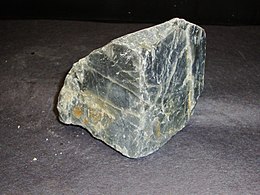Andesine is a silicate mineral, a member of the plagioclase feldspar solid solution series. Its chemical formula is (Ca, Na)(Al, Si)4O8, where Ca/(Ca + Na) (% anorthite) is between 30 and 50%. The formula may be written as Na0.7-0.5Ca0.3-0.5Al1.3-1.5Si2.7-2.5O8.[2]
| Andesine | |
|---|---|
 Andesine | |
| General | |
| Category | plagioclase, feldspar, tectosilicate |
| Formula (repeating unit) | (Ca,Na)(Al,Si)4O8, where Ca/(Ca + Na) is between 30–50% |
| Crystal system | Triclinic |
| Crystal class | Pinacoidal (1) (same H-M symbol) |
| Space group | P1 |
| Unit cell | a = 8.155 Å, b = 12.9 Å, c = 9.16 Å; α = 93.917°, β = 116.3333°, γ = 89.166°; Z = 8 |
| Identification | |
| Color | White, gray, green, yellow, flesh-red |
| Crystal habit | Crystals rare, to 2 cm; commonly massive or granular |
| Twinning | Common following albite, pericline, and carlsbad twin laws |
| Cleavage | Perfect on {001}, good on {010} |
| Fracture | Uneven to conchoidal |
| Tenacity | Brittle |
| Mohs scale hardness | 6 – 6.5 |
| Luster | Subvitreous to pearly |
| Streak | White |
| Diaphaneity | Transparent to translucent |
| Specific gravity | 2.66 – 2.68 |
| Optical properties | Biaxial (+/−) |
| Refractive index | nα = 1.543 – 1.554 nβ = 1.547 – 1.559 nγ = 1.552 – 1.562 |
| Birefringence | δ = 0.009 |
| 2V angle | Measured: 76° to 83° |
| Diagnostic features | Requires optical/chemical analysis |
| References | [1][2][3][4] |
The plagioclase feldspars are a continuous solid solution series and as such the accurate identification of individual members requires detailed optical study, chemical analysis or density measurements. Refractive indices and specific gravity increase directly with calcium content.[5]
Name and discovery
editAndesine was first described in 1841 for an occurrence in the Marmato mine, Marmato, Cauca, Chocó Department, Colombia.[3][4] The name is for the Andes due to its abundance in the andesite lavas in those mountains.[2][5]
In the early 2000s, red and green gemstones began to be marketed under the name of 'andesine'. After some controversy, these gemstones were subsequently discovered to have been artificially-colored.[7]
Occurrence
editAndesine occurs in intermediate igneous rocks such as diorite, syenite, and andesite. It characteristically occurs in metamorphic rocks of granulite to amphibolite facies commonly exhibiting antiperthite texture. It also occurs as detrital grains in sedimentary rocks. It is commonly associated with quartz, potassium feldspar, biotite, hornblende, and magnetite.[2]
References
edit- ^ Mineralienatlas
- ^ a b c d Handbook of Mineralogy
- ^ a b Webmineral data
- ^ a b Mindat.org
- ^ a b Klein, Cornelis, and Cornelius S. Hurlbut, Jr., Manual of Mineralogy, Wiley, 20th ed. 1985, p. 455 ISBN 0-471-80580-7
- ^ Tables of Gemstone Identification By Roger Dedeyne, Ivo Quintens p.118
- ^ "Three Occurrences of Oregon Sunstone | Gems & Gemology".